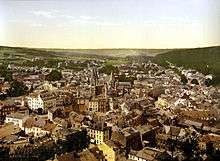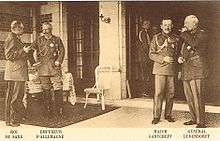Spa, Belgium
| Spa | ||
|---|---|---|
| Municipality | ||
|
The Casino of Spa | ||
| ||
 Spa Location in Belgium | ||
|
Location of Spa in the province of Liège  | ||
| Coordinates: 50°29′33″N 5°51′51″E / 50.49250°N 5.86417°ECoordinates: 50°29′33″N 5°51′51″E / 50.49250°N 5.86417°E | ||
| Country | Belgium | |
| Community | French Community | |
| Region | Wallonia | |
| Province | Liège | |
| Arrondissement | Verviers | |
| Government | ||
| • Mayor | Joseph Houssa (MR) | |
| • Governing party/ies | MR – cdH-OC | |
| Area | ||
| • Total | 39.85 km2 (15.39 sq mi) | |
| Population (1 January 2016)[1] | ||
| • Total | 10,415 | |
| • Density | 260/km2 (680/sq mi) | |
| Postal codes | 4900 | |
| Area codes | 087 | |
| Website | www.spa-info.be | |
Spa, Belgium, is a Belgian town, located in the Province of Liège, and is the town which gave its name to every spa in the world. The town of Spa is situated in a valley in the Ardennes mountains 35 kilometres (22 miles) southeast of Liège and 45 kilometres (28 miles) southwest of Aachen. In 2006, Spa had a population of 10,543 and an area of 39.85 square kilometres (15.39 square miles), giving a population density of 265 inhabitants per km².
Spa is one of Belgium's main tourist cities. The town of Spa is famous for its several natural mineral springs, and is also the location of mineral water producer Spa, whose mineral water is exported worldwide. Nearby Spa, in the village of Francorchamps, the renowned Circuit de Spa-Francorchamps is situated, which hosts the annual Belgian Grand Prix.
The first beauty pageant in the world was the Concours de Beauté, held in Spa on 19 September 1888. Spa is also the location of the world's first Casino.
Spa hosted the finish of Stage 2 of the 2010 Tour de France on July 5.
History

As the famed site of healing cold springs, Spa has been frequented as a watering-place since as early as the 14th century. Though other sources of healing mineral springs have become famous throughout the world, it is the town of Spa which has become eponymous with any place having a natural water source that is believed to possess special health-giving properties, as a spa. The Spa town grew at that time, in the oldest iron and steel center of the country of Liege. The ban Spa, was created around 1335 and included two urban concentrations, "vilhe of Creppe" and "vilhe" Spas, two kilometers away. The steel industry prior to the exploitation of mineral water developed lines of communication, which made possible the development of the spa town.
Pliny the Elder, noted "In Tongrie, country of Gaul, there is a famous source, whose water, while sparkling bubbles, a ferruginous taste that is, however, feel that when we finished drinking. This water purge the body, cures fevers and dispels calculous affections."(C lib.XXXI VIII).
In 1559 appeared in the famous work of Gilbert Lymborh "Fountains acids of the Ardennes forest and primarily those located in Spa." It was translated into Latin, Italian and Spanish.
In 1547 already, Agustino, physician to the King of England, Henry VIII, was staying at Spa and helped give knowledge to the world of the value of the Spa water. In July 1565 the gentry of the provinces met in Spa under the pretext of taking the waters.

It is in the hotel "Aux Armes of England" it was agree to oppose the edicts of Philip II which were austere and intolerant; this is the history "Compromise of Nobles."
In 1654, the stay of Charles II of England in Spa will brought even greater fame. From 1699, a postal system is set up between Spa and the outside world.
Since the 18th century casinos have also been located in the town.

Twentieth Century
In 1918, the German Army established its principal Headquarters in Spa, and it was from here that the delegates set out for the French lines to meet Marshal Foch and sue for peace in the consultations leading up to the Armistice which ended the First World War.

During the Great War of 1914-1918, Spa was an important German convalescent hospital town from 1914 to 1917. The general headquarters of Kaiser Wilhelm II was, in 1918, the last place where he resided before his removal due to the German surrender. In 1920, In July 1920 it hosted the Spa Conference, a meeting of the Supreme Council. German delegates were invited to this to discuss war reparations.
World War II saw Spa reoccupied by the Germans but escaped the Battle of the Bulge in 1945 that stopped, luckily for her, just at its gates.
The Marshall Plan, helped Belgium to recover quickly. 1950 and 1960, gradually led to the development of mass tourism replacing timely Spa elite of customers. These are the decades of social tourism as well, with an attendance of more and more numerous of Flemish and Dutch customers, while the Walloon went to mass at the Belgian coast in Flanders. Tourism relaxation takes over the thermal aspect of Spa.
May 17, 1983 to mark the 400th anniversary of the export of Spa waters,[2] HM King Baudouin visited the new facilities of the Spa Monopole SA, the Henrijean Hydrology Institute and the Thermal Establishment. A special train Brussels-Spa led the morning delegates and foreign and Belgian journalists. On behalf of the European Association and the European Union Sources of natural mineral water which is headquartered in Paris, Paul Bordier, president at the annual conference of the association, gave the train a conference dealing European mineral water market. Then, arriving by helicopter, King Baudouin lands in the park fermière[3] Company and visited the city and its tourist facilities and spa.
The years 1980 and 1990, announced the beginning of an infrastructure renewal and Spa radiation. In 1994, a new French song festival is created: the "Francofolies".
In 2007, 150,000 spectators attend the festival. In 1997, the area of Spa-Bérinzenne opens the Education Centre on the environment one of whose specialties is water, etc.
Twenty-first century
In 2005, a new center "thermoludism" born on the hill of Annette and Lubin with panoramic views of the city. It is directly linked by funicular to the heart of the city and a new hotel luxe.
In 2007, the Spa-Francorchamps circuit completely renew its infrastructure to comply with the best international standards, allowing it to continue to host each year, the Formula One Grand Prix 1 in Belgium, in addition to many other sporting events annual.
Heraldry
The Coat of Arms for Spa is a stylized pouhon housed in a neoclassical monument to the covering surrounded by a protective wall opened its facade. The monument is topped by a blue banner bearing the "Spa-Pouhon" inscriptions. "Argent masonry money pouhon of sand topped with gold-SPA Pouhon inscriptions on a blue background." The city colors are yellow and blue. The stylized pouhon is inspired by the monument that housed the pouhon Peter the Great until 1820.
Under the Old Regime, the shield was commonly used in spa towns. It was customary for the spa guests to leave their arms at the hotel where he had stayed in recognition of the benefits of the waters. At Spa, many hotels have inscriptions like "In the Arms of England", "the Duke of Orleans," "To the King of Poland", etc.
Climate
| Climate data for Spa | |||||||||||||
|---|---|---|---|---|---|---|---|---|---|---|---|---|---|
| Month | Jan | Feb | Mar | Apr | May | Jun | Jul | Aug | Sep | Oct | Nov | Dec | Year |
| Average high °C (°F) | 4 (40) |
5 (41) |
8 (47) |
12 (53) |
17 (63) |
19 (66) |
21 (69) |
20 (68) |
18 (64) |
13 (56) |
7 (45) |
5 (41) |
12 (54) |
| Average low °C (°F) | −1 (30) |
−2 (29) |
1 (33) |
3 (37) |
7 (44) |
9 (49) |
11 (52) |
11 (52) |
9 (48) |
6 (42) |
2 (35) |
−1 (31) |
4 (40) |
| Average precipitation mm (inches) | 97 (3.8) |
84 (3.3) |
79 (3.1) |
81 (3.2) |
80 (3) |
99 (3.9) |
112 (4.4) |
99 (3.9) |
84 (3.3) |
94 (3.7) |
99 (3.9) |
109 (4.3) |
1,113 (43.8) |
| Source: Weatherbase [4] | |||||||||||||
Notable residents
- Georges Krins, a violinist on the RMS Titanic.
- Giacomo Meyerbeer, composer, completed here his opera Robert le diable in 1830.

References in popular culture
The 1975 film Barry Lyndon is partly set in Spa during the eighteenth century.
The 1975 film Belle is wholly set in contemporary Spa and its environs.
Agatha Christie's fictional detective Hercule Poirot was born in Spa.
International relations
Twin towns - Sister cities
Spa is twinned with:
See also
References
- ↑ Population per municipality as of 1 January 2016 (XLS; 397 KB)
- ↑ http://www.spadel.com/.
- ↑ Extrait de l'article du journal La Vie spadoise.
- ↑ "Weatherbase: Historical Weather for Spa, Belgium". Weatherbase. 2011. Retrieved on November 24, 2011.
External links
| Wikimedia Commons has media related to Spa, Belgium. |
 |
Theux |  | ||
| Theux | |
Jalhay | ||
| ||||
| | ||||
| Stoumont | Stavelot |


